
| Table of Contents | History of Strzyzow | JewishGen’s Strzyzow Page | Historical & Genealogical Records | Families from Strzyzow |
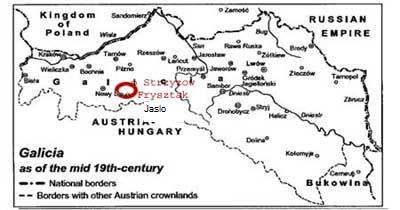 at latitude 49° 52´, longitude
21° 48´'.
at latitude 49° 52´, longitude
21° 48´'.
The cities and towns surrounding Strzyzow are (clockwise): Rzeszow (15 miles North), a very important Jewish city, Czudec (6 miles North), Tyczyn (12 miles East), Blazowa (13 miles East), Niebylec (4 miles East), Domaradz (9 miles SE), Lutcza (6 miles SE), Jasienica Rosielna (10 miles SE), Korczyna (10 miles South), Krosno (13 miles South), Jedlicze (12.3 miles South), Jaslo (17 miles West), Frysztak (8 miles West), and Wisniowa (6 miles West).
Those towns underlined above, have a shtetl page which you can
also visit (just click on the town name). Nearby towns are
important because  in those days most trade and many Jewish
marriages were arranged with Jews from a nearby town. Thus you may
find family information in surrounding towns.
in those days most trade and many Jewish
marriages were arranged with Jews from a nearby town. Thus you may
find family information in surrounding towns.
Do keep in mind that the spellings of all towns and even the
surnames changed along with the times, the governments and the
official languages.
There was a Jewish presence in Strzyzow as early as the 16th
century, but it was not until the 18th century that the synagogue
was built. My great grandmother Frieda Necha KANDEL
was born in Strzyzow in 1860 (the photo is from 1913). Frieda
married Josef SCHEINER, a schochet from the
nearby town of Dubetsk. They emigrated to the United States in the
late 1890s. 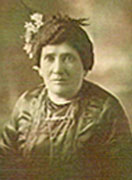 I have created
this web page in loving memory of those who lived and died there,
and of those who ventured out, for they left us a wonderful
legacy. I have collected all the data sent to me on Strzyzow and
will continue to build this page as photographs, stories and
records are made available.
I have created
this web page in loving memory of those who lived and died there,
and of those who ventured out, for they left us a wonderful
legacy. I have collected all the data sent to me on Strzyzow and
will continue to build this page as photographs, stories and
records are made available.
Alas, today, there are no Jews in Strzyzow. It was with great
sadness that we learned of the fate of the Jews of Strzyzow in
1942.....almost all the Jews were killed. Much of the history of
Strzyzow was told in the Yizkor Book, Sefer Strzizhuv, which
was published in Tel Aviv in 1969; excerpts are now available on
the web (thanks to JewishGen and a dedicated band of Jewish
genealogists). 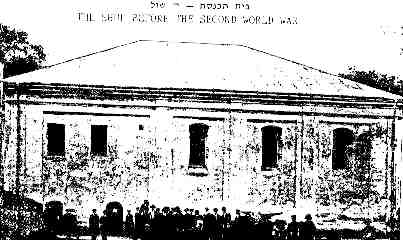 Below you will find a
link to this book which tells of a Strzyzow that was a vibrant
shtetl.
Below you will find a
link to this book which tells of a Strzyzow that was a vibrant
shtetl.
Up until 2019, Phyllis Kramer (OBM) developed and maintained this KahilaLink. Phyllis did a wonderful job documenting and sharing information about this shtetl. Starting in July 2021 Jeff Alexander is trying to fill Phyllis’ shoes. Please contact Jeff Alexander for anything related to this shtetl
Copyright © (2022) Jeffrey Alexander. All rights reserved.
![]() click to return to the
JewishGen Home Page. Please note that this site exists
because of your Jewish Gen-erosity. Your tax deductible donation
to JewishGen makes these services possible. We spent a lot of time
organizing this information so that your genealogical search might
be more rewarding....and you can reward us -- just click on
Jewish Gen-erosity.
click to return to the
JewishGen Home Page. Please note that this site exists
because of your Jewish Gen-erosity. Your tax deductible donation
to JewishGen makes these services possible. We spent a lot of time
organizing this information so that your genealogical search might
be more rewarding....and you can reward us -- just click on
Jewish Gen-erosity.

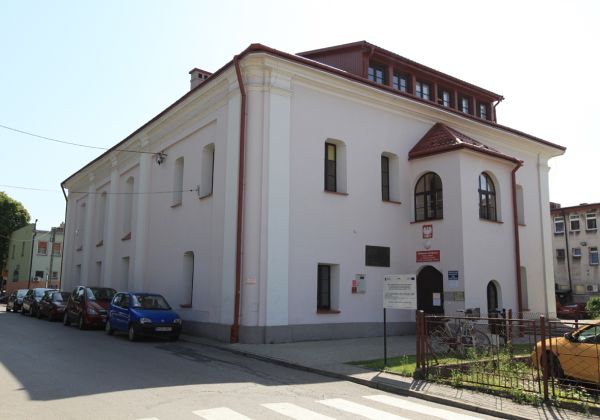

 photographs courtesy
Edward Maurer and family; Dec2011
photographs courtesy
Edward Maurer and family; Dec2011 
 March 2011
March 2011 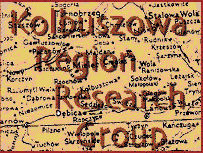 Strzyzow
is about 25 miles south of Kolbuszowa and thus included in the
Kolbuszowa Region Research Group (KRRG). The KRRG web site has
resources and information that may be relevant. To search for
family links and learn more about neighboring shtetlach,
please visit the Kolbuszowa
Region Research Group
Strzyzow
is about 25 miles south of Kolbuszowa and thus included in the
Kolbuszowa Region Research Group (KRRG). The KRRG web site has
resources and information that may be relevant. To search for
family links and learn more about neighboring shtetlach,
please visit the Kolbuszowa
Region Research Group 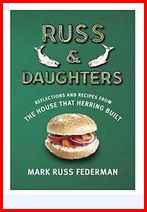

 The Yizkor book is now online! Both
English and Hebrew/Yiddish! click for details! 2006
The Yizkor book is now online! Both
English and Hebrew/Yiddish! click for details! 2006 
 Aug 2012
Aug 2012 According to the 1900 census, 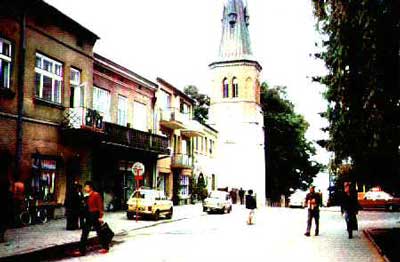 Strzyzow was a district of Galicia (a province of
Austria-Hungary). At that time there were 2000 inhabitants, 992
of which were Israelitsch (Jewish). The census noted there was a
Synagogue. Surrounding towns with a Jewish presence included
Czudec (1214 residents, 410 Jewish), Niebylec (687 residents,
343 Jewish), and Frysztak.
Strzyzow was a district of Galicia (a province of
Austria-Hungary). At that time there were 2000 inhabitants, 992
of which were Israelitsch (Jewish). The census noted there was a
Synagogue. Surrounding towns with a Jewish presence included
Czudec (1214 residents, 410 Jewish), Niebylec (687 residents,
343 Jewish), and Frysztak.
In 2011 I received the following email from Rose Steszewski:
During the 16th century, Baron Strezow was a wealthy land baron
who established the tiny town of Strezow located in Southern
Poland. His family crest was that of Saint Michael the Archangle
and the lady holding the scales of justice. Today, the Strezow
family lives in various places. Their name became Steszewski,
which is my last name. The history of Strezow is in "Polish
Room" at the U of Buffalo. My father's family moved to an area
outside of Colon Germany where they were wealthy land barons; My
cousin Carol Steszewski is the genealogist. I am amazed that my
ancestral line is Jewish; My Dad always thought that he was
Polish; he was very attractive, intelligent, and philisophical
in nature. My mother, Yianoula Pappafagos is Greek Orthodox
Cathollic but were were Jewish for generations. When one gets
into the family tree, one then discovers that this family of
mankind is one small extended family.Shalom! Rose Steszewski
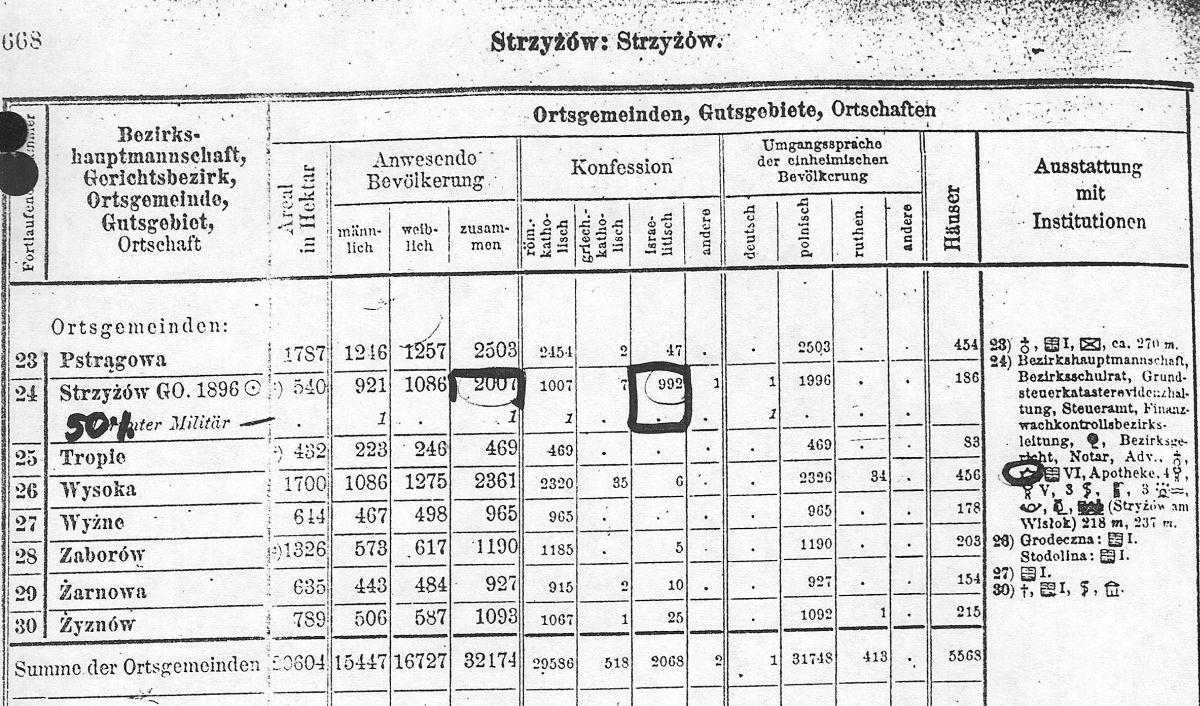

The photographs below show the synagogue today...now a library (Bibliotek)....the interior photo looks up to the women's section ... all courtesy of Estelle Guzik.
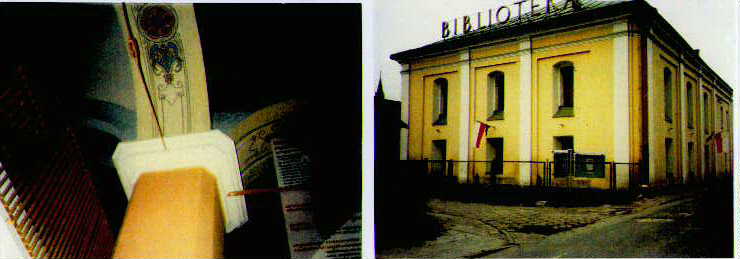
And this taken in 2017 sent by Sonja 
In the summer of 1995, we traveled to Belarus, Lithuania, and Poland, to visit the shtetls of our grandparents Although we had done some archival research, the focus of this journey was to stand on the soil where our grandparents had been born, and from which they had emigrated between 1890 and 1910.
We each had a bit of evidence identifying our grandparents' shtetls. Rochelle had the last postcard sent by her grandmother's brother from Poland in 1938 or 1939. Before we left for Eastern Europe, we made contact with extended family and professional guides who could take us to the towns that we wanted to visit.
In most towns, we found no specific remnants of our
families, but we were able to walk down the streets with
homes which had been standing when our grandparents lived
there, and by the rivers where we could imagine our
grandmothers washing their clothes and bathing. We came
closer to touching base with lost relatives in Dobrzhechov
(2.5 miles east of Strzyzow),  where we found the
house in which Rochelle's two great uncles had lived.
Rochelle had a postcard, written by Aron Ichel to his sister
Rose in 1938 or 1939. He spoke about his hardships, the
sickness of his son, that he and his family had been forced
to leave Dobrzhechow and move to Strzyzow, how he went back
to the village to get chickens to sell at the market, how he
observed the Yahrzeits of their parents, and how he
desperately needed money.
where we found the
house in which Rochelle's two great uncles had lived.
Rochelle had a postcard, written by Aron Ichel to his sister
Rose in 1938 or 1939. He spoke about his hardships, the
sickness of his son, that he and his family had been forced
to leave Dobrzhechow and move to Strzyzow, how he went back
to the village to get chickens to sell at the market, how he
observed the Yahrzeits of their parents, and how he
desperately needed money.
We went to Dobrzhechow, a cluster of wooden and stucco houses dominated by a large stone Catholic church. Our guide found a man who knew Aron and David Ichel. He had been a child, so only knew their first names. He pointed out their house and told us where Aron had moved to in Strzyzow. Aron, he said, had been a good man, who even gave boots to one poor peasant who worked for him. Evgenii had told us that Jewish houses generally had doors opening on to the street, so that they could have small shops in them, while the Poles' homes had doors on the sides of their houses. Often, these were bearded up by the Poles who moved into them after the Jews were murdered. And sure enough, Aron's house had a front entrance, a door leading nowhere, with no steps.
Genealogical research involves time, dogged detective work, and luck. Was it 'bashert' or coincidence that Rochelle met Sophie Furman, another Strzyzower, at Klezkamp in the CatskilIs in 1994? This set in motion a series of connections that will lead us, in another trip, to the gravestone of Rochelle's great-grandparents. Sophie put Rochelle in touch with Harry Langsam, a Strzyzower now living in Los Angeles, who had emigrated before the World War II and had translated the shtetl's yizkor book from Yiddish to English. From him, Rochelle learned that many of the Strzyzow Jews were sent to one of the first death camps, Belzec, in 1942. Through him, she also learned about the Strzyzow Society in Israel, and specifically about Chaim Ben-Zvi (Mohrer) , a Tel Aviv octogenarian who traveled to Strzyzow after our visit to restore the gravestones in the Jewish cemetery with the help of a Polish family. We had of course visited the cemetery (as we visited every Jewish cemetery and mass grave on our route) and seen evidence of some restoration funded by the Lauder Foundation, but also a pile of broken gravestones in the middle of the cemetery. Through Harry Langsam, we found out that Ben-Zvi had restored the gravestones ...Now Rochelle and Chaim Ben-Zvi are in direct communication through email, and she has found out that the Ichels were major milk producers for Strzyzow.
In 1992 the US Commission reported on all the cemeteries in Poland. The report included the following information on Strzyzow's 3 Jewish cemeteries:
The first cemetery was/is located on Przeckawczyka Street, across from the synagogue. It was established in the 16th-17th Century. The cemetery is located in an urban area, isolated, without a sign or marker, but it is surrounded by a continuous fence. Before WWII the cemetery was about 500 square meters, but it does not exist now. It is currently owned by the municipality, and is used as a park.
The second cemetery report is on ul. Daszynskiego. The cemetery location is urban, isolated with no sign or marker. The cemetery is reached by turning directly off a public road; it has a piece of broken fence and no gate. This cemetery was 1,000 sq. meters pre-WWII. No stones are visible. There are no known mass graves. The municipality owns the property. The cemetery property is now used only for recreational purposes.
The third cemetery is on ul. Wschodnia. The last known
burial was during WWII. It was established in 1850. The
cemetery location: rural, on a hillside, isolated with no
sign or plaque. The cemetery has a piece of broken masonry
wall and no gate. The 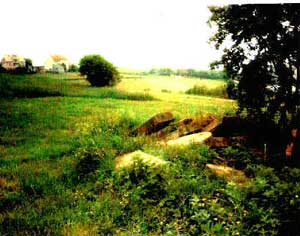 cemetery was 500 sq. meters before and after WWII. 1-20
stones are visible with none in their original location
and less than 25% broken. The oldest known gravestone is
from the 19th century. The municipality owns the property.
The cemetery property is now used only for Jewish cemetery
purposes.
cemetery was 500 sq. meters before and after WWII. 1-20
stones are visible with none in their original location
and less than 25% broken. The oldest known gravestone is
from the 19th century. The municipality owns the property.
The cemetery property is now used only for Jewish cemetery
purposes.
The photo to the left pictures the remaining tombstones in the former Jewish Cemetery...1986, courtesy of Estelle Guzik.
,b.The following was exerpted from a polish site celebrating the Jewish cemeteries of Poland: http://www.kirkuty.xip.pl/nowyzmigrod.htm:
In Strzyzów there were three Jewish cemeteries . The oldest one located in present Przeclawska street was mentioned for the first time in 1703. Most likely it was set up earlier at the same time when the local kehilla was established.
The second cemetery of the local Jewish community was situated in Daszynskiego street . Today there is a parking lot and kids play football in that place. As a result of the WW II both necropolises vanished.
Till present only the newest cemetery established in the end of the 19th century on Tarnowska Góra survived . Thanks to an initiative of the Nissenbaum Family Foundation as well as Jews form Strzyzów and their progeny, at the turn of the eighties and nineties of the 20th century the necropolis area was tied up and enclosed and few dozen of gravestones were recovered. Mr. Chaim Ben Zwi vel Henryk Moher who comes from Strzyzów did cataloguing works. He made a list of all matzevas and reread names and family names of deceased. The oldest identified matzeva comes from 1884 and commemorates man named Icchak. By the entrance there is a plate with following inscription installed: "The cemetery enclosure was built by the Nissenbaum Family Foundation - Warsaw in agreement with Rabbi Samuel Teitelbaum, Rabbi Josef Chaim Frenkel, Rabbi Abraham Frenkel from New York ". An ohel covering grave of rabbi Alter Horowitz was also erected. On the 20th August 1996 in connection with finish of the ohel erection, a special ceremony took place at the cemetery. The grandson of rabbi and representatives of Jewish groups as well as local authorities and public organizations among others Zygmunt Nissenbaum - chairman of the Nissenbaum Family Foundation and Hertz Frankel - chairman of International Committee on Jews Affairs and the US president advisor on Jewish Affairs and Marek Sliwinski - the town mayor took part in it. After official statements Kaddish was said.
The photographs of the Strzyzow Cemetery below are
current and were taken off the Polish Cemetery Web site
http://www.kirkuty.xip.pl/strzyzow.htm 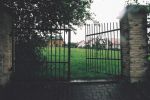
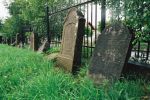
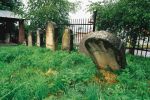
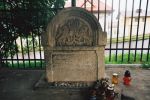
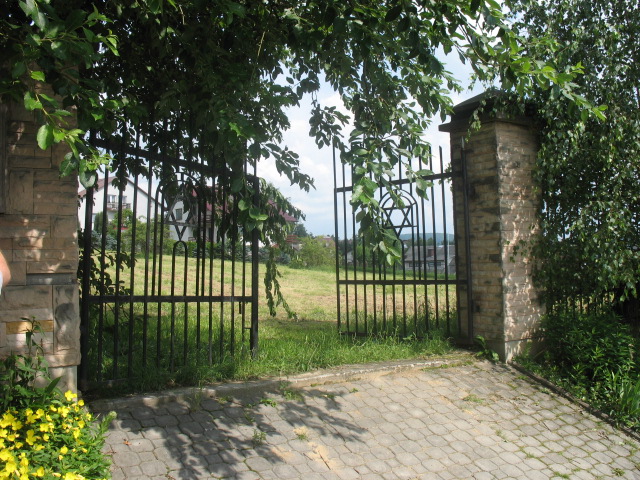
The following is from a letter written by Chaim Ben-Zvi of Tel Aviv on June 4, 1996 to Rochelle Ruthchild:
I was born in 1915, left Strzyzow Dec 1934 and arrived in Jaffa Tel Aviv January 1935. In that time, Israel (Palestine) was under the British Mandate, and I had to learn English in order to progress. Now, after I retired (1980) I don't use that language, and therefore I ask to forgive me the errors and mistakes.
In August 1990 I came to Strzyzow with the decision to find out the Mazevoth (gravestones) of my dear parents (father died in 1925, mother in 1932). I got from Warsaw authorities and from the Mayor of Strzyzow (Mr. Slivinski) all confirmations and started to work. I restored 18 Mazevoth till I find out the Mazevoth of my parents. I left Strzyzow to Tel Aviv with the hope that in the next years we shall restore the pile of Mazevoth I left unrestored. Five years passed, and on August 23, 1995 I flew again to Strzyzow, and with workers and tractor ...of the last Jewish Cemetery in Strzyzow.
In Jan. 1996 I ...sent the plan and list of all the 109 Mazevoth...
One thing I want to emphasize: I had a MAZAL to meet in Strzyzow a young Polish family named Alicja and Pawel Gwiszck (he was born in 1961). Without these young couple I wouldn't be able to do all what we have done. If anyone desires to visit Strzyzow and the former Jewish places around, the best is to connect with Gwiszck. He did all; restored the Mazevoth; made all the video films; took me with his car from Warsaw Airport to Strzyzow, and brought me back (after one month staying with them) to Warsaw Airport.
yours truly, Chaim Ben-Zvi
The Cemetery List, with Dates: (if
any) 
Note: The photo to the right pictures the remaining tombstones in the former Jewish Cemetery...1986, courtesy of Estelle Guzik. Below that is the cemetery plan as created by the late Chaim Ben-Zvi of Israel
The list was updated in 2012, see below.
From Estelle Guzik, president of the NY Jewish Genealogical Society: "I'm sitting here with goose bumps! My great grandfather Chaim Guzik lived and died in Strzyzow. Gitel has to be part of my family. His mother was Gitel Guzik, my great great grandmother."
I am Shimon Nitzan, the son of Shoshana Schefler from Strzyzow.Ten years ago I sent you coverage of the Schefler family gathering which took place in Sdot Yam in 2001.This summer (August 2012) we organized a visit in Poland which included 16 family members representing the families Schefler, Felder and Rosen Originating fromStrzyzow.
The main objective of the trip was a visit to Strzyzow which included a visit in the cemetery and cleaning of tombstones and identifying the tombstones of our family. On this occasion we were remapping of all the tombstones continuation of the work of mapping done at the time by Mr. Chaim Ben-Zvi (Maurer).We have invested a lot of work for long hours cleaning and identifying the tombstones, unfortunately some of them couldn't be identified.
In addition, we met with representatives of the
municipality which received us warmly. I'd be happy if
you keep adding to Strzyzow website the materials I sent
you or at least part of it.If you have any questions or
requests about the material, do not hesitate to contact
me.
Sincerely
Shimon Nitzan
In August 2012, we arrived in Strzyzow 16 family members – Schefler, Felder and Rozen descendants from Strzyzow born relatives. During our stay, we cleaned and re-mapped the tombstones that were identifiable .Two mapping versions have been registered: the one made by Chaim Ben-Zvi (Mohrer) and ours.

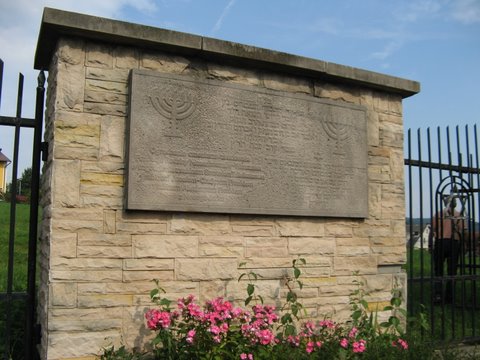
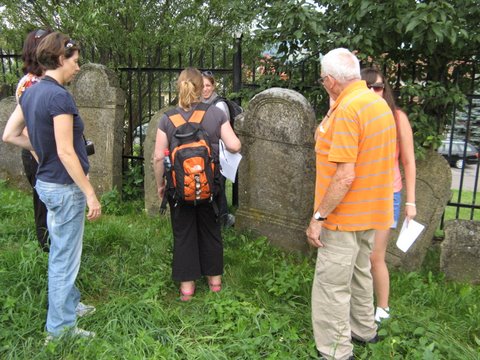
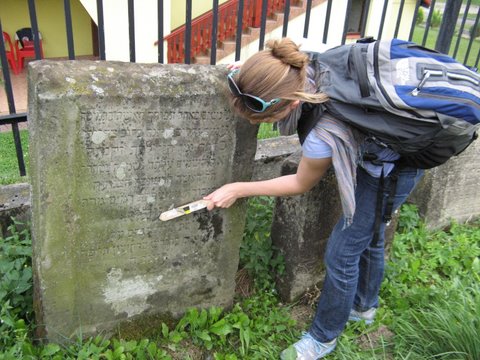
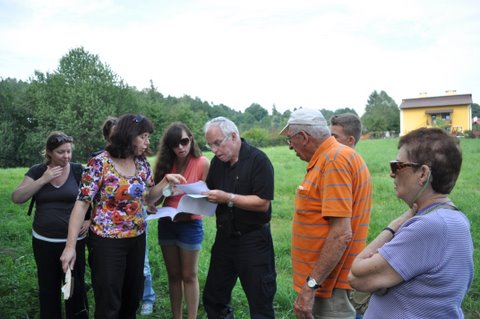
| New Numbers 2012 | Previous Numbers 1990/95 | Name as written on the tombstone (Hebrew) | Name as written on the tombstone (English) | Date of Death |
| |
Tombstones | from No. 1 till No. 38 | (West side) | |
| 1 | 36 | לא מזוהה | Unidentified | |
| 2 | 35 | דבורה בת יצחק | Dwora Bat Yichak | |
| 3 | 34 | יחיאל רוזן | Yehiel Rosen | 1913 |
| 4 | 33 | יהושע אביגדור להריך | Jehoshaw Avigdor Lerich | 1937 |
| 5 | 32 | אליעזר | Eliezer | |
| 6 | 31 | אסתר | Ester | |
| 7 | 30 | אסתר זילברמן | Ester Zilberman | 1939 |
| 8 | 29 | סריל | Seril | 1917 |
| 9 | 28 | פרידה סגל בת הרב אלישע | Frida Segal | 1919 |
| 10 | 27 | אסתר דעמביצער | Ester Dembicer | |
| 11 | 26 | באשע בת יצחק | BasheBat Yichak | 1922 |
| 12 | 25 | לא מזוהה | Unidentified | |
| 13 | 24 | עקיבא שמואל טענצער | Hakiva Shmuel Tencer | |
| 14 | 23 | אביגדור בן מנחם יצחק מאהרער | Avigdor Mohrer | 1928 |
| 15 | 22 | לא מזוהה | Unidentified | |
| 16 | 21 | משה יהושע רוזן | Moshe Jehoshaw Rosen | 1935 |
| 17 | 20 | צבי הירש בן חיים מורר | Zwi Hirsh Mohrer | 1928 |
| 18 | 19 | חיה אסתר מאהרער | Chaje Ester Mohrer | 1932 |
| 19 | 18 | חנה בת אלחנן | Hana Bat Elchanan | 1915 |
| 20 | 17 | דב דוד | Dov David | 1902 |
| 21 | 16 | יוסף שאכער | Josef Shacer | 1928 |
| 22 | 15 | צבי הערש שיף | Zvi Hersh Shiff | 1934 |
| 23 | 14 | תנחום יעקב | TanhoumYaakow | 1906 |
| 24 | 13 | פנחס טארק | Pinhas Terk | 1924 |
| 25 | 12 | בנימין יהושע העשל גולדברג | Binyamin Jehoshaw Heshel Goldberg | 1918 |
| 26 | 11 | אברהם אבא מילר | Abraham Aba Miller | 1933 |
| 27 | 10 | אברהם קעה | Abraham Keh | |
| 28 | 9 - 8 | יוסף חיים דיאמנט | Josef Haim Diamand | 1929 |
| 29 | 7 | פרומא רבקה לנגזם | Frima Rivka Langsam | 1922 |
| 30 | 6 | גיטל באבטשע | Gitel Babtshe | 1927 |
| 31 | 5 | לאה בערגער | Lea Berger | 1922 |
| 32 | |
אהל הרב זאב הורוביץ | Tent of Rabbi Zeev Horovitz | |
| 33 | 4 | לאה מרים רוזן בת בן ציון | Lea Miriam Rosen | 1936 |
| 34 | 3 | פעסל מרים ברגלס בת מרדכי גימפל | Pessel Miriam Berglas Bat Mordechai Gimpel | 1938 |
| 35 | 2 | חיים הוזענקאפף | Haim Hazenkoph | 1933 |
| 36 | 1 | שמשון קעטט | Shimshon Kett | 1933 |
| 37 | 37 | ישראל בן אברהם יהודה מצאבדזעכאוו | Israel Dobrzechowa | 1913 |
| 38 | 38 | בינא גוטמן | Bina Gutman | 1929 |
| |
Tombstones | from No. 39 | till No. 109 (South side) | |
| 39 | 39 | קריינדלר קאט | Kreindler Kett | 1926 |
| 40 | 40 | יוסף רודלבטר | Josef Ruderbeite | |
| 41 | 41 | רבקה בת אהרון | Rivka Bat Aaron | |
| 42 | 42 | פערל איכעל מצאבדזעכאוו | Peril Eichel Dobrzechowa | |
| 43 | 43 | צבי הרש בר ברגלס | Zvi Hersch Ber Berglas | |
| 44 | 44 | רעכיל קארף | Rechel Karph | |
| 45 | 45 | נחמה רועס | Nechama Ross | 1923 |
| 46 | 46 | לא מזוהה | Unidentified | |
| 47 | 47 | לא מזוהה | Unidentified | |
| 48 | 48 | יחזקאל | Yschezkel | |
| 49 | 49 | אהרון קאננער | Aaron Kanner | ?192 |
| 50 | 50 | אליעזר רוזנבליט | Elazar Rosenblith | ?193 |
| 51 | 51 | יקותיאל הכהן | Yekutiel Hacohen | |
| 52 | 52 | זיסל בורגניכט | Zissel Borgenich | |
| 53 | 53 | לא מזוהה | Unidentified | |
| 54 | 54 | מינדל בת משה | Mindel Bat Moshe | 1911 |
| 55 | 55 | ביילא פרידמאן | Beila Friedman | 1915 |
| 56 | 56 | לא מזוהה | Unidentified | |
| 57 | 57 | מיכא קאננער | Mecha Kanner | 1925 |
| 58 | 58 | כהן | Cohen | |
| 59 | 59 | לא מזוהה | Unidentified | |
| 60 | 60 | מרים בת שלמה | Miriam Bat Shlomo | |
| 61 | 61 | לא מזוהה | Unidentified | |
| 62 | 62 | מאלי בת חיים | Mali Bat Haim | 1913 |
| 63 | 63 | לא מזוהה | Unidentified | |
| 64 | 64 | עקיבא שאנעל | Akiva Shennel | |
| 65 | 65 | אסתר בת שלמה | Ester Bat Shlomo | |
| 66 | 66 | שרה בת נטע | Sara Bat Netah | 1914 |
| 67 | 67 | גיטל בעערובעה-דאברא | Gitel Baaruba - Dobra | 1914 |
| 68 | 68 | דאברא יענטא | Dobra Yenta | |
| 69 | 69 | מלכה בת שמואל | Malka Bat Samuel | 1925 |
| 70 | 70 | לא מזוהה | Unidentified | |
| 71 | 71 | בילא כץ | Beila Katz | 1924 |
| 72 | 72 | יהנא נאכא | Yene Necha | 1897 |
| 73 | 73 | לא מזוהה | Unidentified | |
| 74 | 74 | לא מזוהה | Unidentified | |
| 75 | 75 | חנה קרויס אשת דוד | Hana Krois | |
| 76 | 76 | ליבא שטורם | Libe Sturm | |
| 77 | 77 | לא מזוהה | Unidentified | |
| 78 | 78 | שרה ליבא | Sara Leiba | |
| 79 | 79 | דבורה פירסט | Dwara Fierst | |
| 80 | 80 | חיה | Haya | 1916 |
| 81 | 81 | מהלה דבורה | Mahala Dobra | 1920 |
| 82 | 82 | טובה חוה סגל | Tauba Hava Siegel | 1920 |
| 83 | 83 | לא מזוהה | Unidentified | |
| 84 | 84 | יהודה נתן | Yehuda Natan | |
| 85 | 85 | דוצא וילופולא | Deutschz Wielopole | |
| 86 | 86 | גיטל גוזיק | Gitel Guzik | |
| 87 | 87 | אסתר הלוי | Ester Halevi | 1924 |
| 88 | 88 | לא מזוהה | Unidentified | |
| 89 | 89 | משה מאנטול | Moshe Mantel | 1934 |
| 90 | 90 | לא מזוהה | Unidentified | |
| 91 | 91 | רחל | Rachel | |
| 92 | 92 | יצחק | Yichak | 1884 |
| 93 | 93 | סטאואה קאלב | Stawa Kalb | |
| 94 | 94 | לא מזוהה | Unidentified | |
| 95 | 95 | פעריל | Peril | |
| 96 | 96 | גיטל מירל בת אברהם | Gitel Mirel | |
| 97 | 97 | אהרון | Aharon | 1928 |
| 98 | 98 | רחל לאה בת דוד | Rachel Lea Bat David | ?191 |
| 99 | 99 | פרידה יענטא בת ישעיה מינץ | Frida Yenta Bat Ishayia Mintz | |
| 100 | 100 | שפרינצה פריידה רחל | Shprica Freyida Rachel | |
| 101 | 101 | מלכה רוזה טייטעלבויים | Malka Roza Teitelbaum | 1938 |
| 102 | 102 | צבי שלמה בן משה שמואל | Zvi Shlomo Ben Moshe Shmuel | 1915 |
| 103 | 103 | שמעון | Shimon | |
| 104 | 104 | לא מזוהה | Unidentified | |
| 105 | 105 | פנחס | Pinhas | 1891 |
| 106 | 106 | יחזקאל קופמאן | Yehezkiel Kaufman | 1934 |
| 107 | 107 | לא מזוהה | Unidentified | |
| 108 | גנענדל דיאמאנט בת משה | Ginendel Diamant Bat Moshe | 1937 | |
| 109 | יחיאל יהודה בן אברהם מינץ | Yehiel Yehuda Ben Abraam Mintz | 1937 |

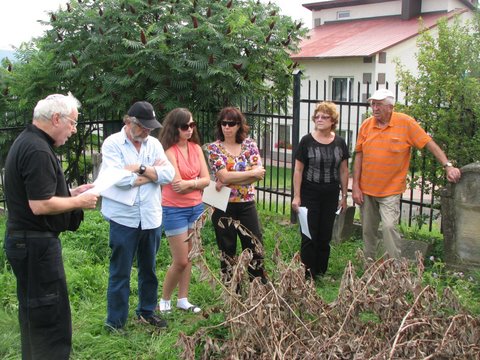

The description is at http://tracingthepast.org/minority-census. It reads: "Currently, the searchable data includes persons who can be proven to have perished in the Holocaust, those who were born prior to 1903 (+110 years ago), and others who deceased prior to 1984 (+30 years ago). Of the approximately 410,000 original entries, about 275,000 (or around 67%) of the "Minority Census" are available here online... Tracing the Past is honored to have the opportunity to share this research tool online. " and the index can be searched here:
http://tracingthepast.org/minority-census/census-database
The folks born in Strzyzow (with birthdates) and living in Germany in 1939 included:
In February of 2011 we received a list of 1920-1930 school students from the Strzyzow Coeducational Gimnasium. The following surnames are present:
Harry Langsam wrote about an active secretary of the Strzyzow Landsmanshaft, Samuel Mussler, who extended tremendous help after World War II to the surviving natives of Strzyzow.
The Polish National Digital Archives has posted wonderful photographs from some of our shtetls in the 1920s and 1930s. You can search for your shtetl by going to http://www.audiovis.nac.gov.pl/obraz/; put the town name (as it is spelled today) in the box on the upper left hand corner. Each photograph is labeled and dated.
Our friend Monika, who was born in Poland, has translated some of the captions, but you can do this too, by using poltran at http://www.audiovis.nac.gov.pl/obraz/. Just cut and paste the caption into the search box.
The photograph below is the 20th anniversary of
Strzyzow's Gymnasium or High School. Its a splendid
photograph taken in 1932. 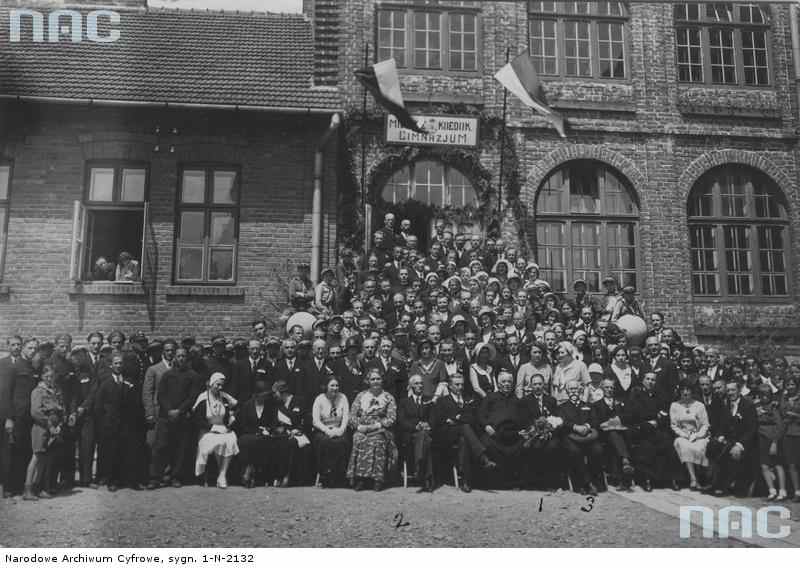
The next photograph comes from nearby Krosno. It shows
Krosno town leaders Greeting the President of the Polish
Republic, Ignacy Moscickiego, in March of 1927. 